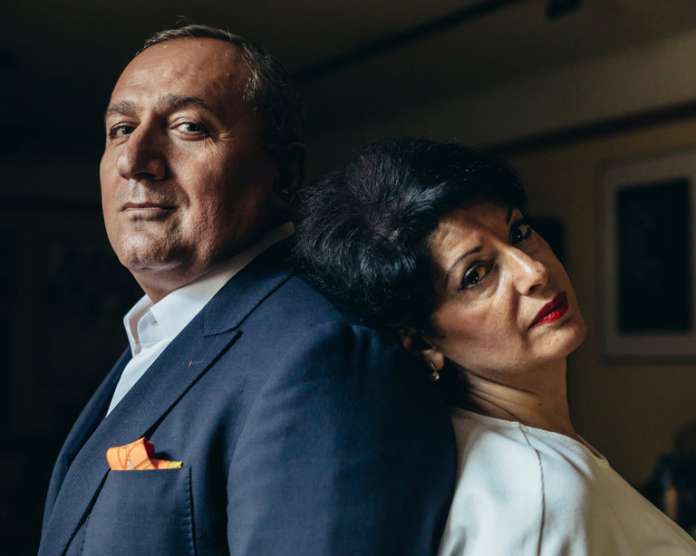
It started at the Russian Academy of Theater Arts in Moscow in 1982. Sergei Danilian wanted to impress a girl.
“She broke her high heel,” Mr. Danilian, 57, said in a recent interview. “She asked me to fix it. I was thinking, oh my God, she is such a cute girl from probably a rich family. How am I going to handle her? I picked up a job in the dorm in the night shift of security to earn the money to be able to handle Gaia.”
Gaia, or Gaiane Danilian, now 52, eventually became his wife and business partner. Seated opposite him in their City Center office, where their arts management company, Ardani Artists, is headquartered, she muttered, “Oh, please.”
But money was scarce. He studied history; she focused on arts management. Suddenly, Mr. Danilian’s course of education and his emerging career as a critic no longer seemed like a practical way to earn a decent living. What’s more, he didn’t want to write about art; he wanted to produce it.
Mr. Danilian does make art — and especially dance — happen. His latest theatrical concoction will be on display at City Center on Aug. 19 and 20 in the “Ardani 25 Dance Gala,” an anniversary program that showcases the work of new choreographers.
His love of dance was born not from watching a specific performance, but from reading. He was also inspired by an exhibition he saw in Moscow in 1981, “Paris-Moscow 1900-1930,” which looked at, in part, Diaghilev’s Ballets Russes. Of Diaghilev, the great Russian impresario, Mr. Danilian said: “I am jealous. You know why? He lived in the time of great artists working around him. That doesn’t mean we don’t have great artists now, but it was really different. There was magic around him.”
But he, too, prides himself on being that old-fashioned thing: an impresario. In 1990, he formed Ardani Artists in Moscow; in collaboration with others, it brought American artists to Russia — Merce Cunningham, the Limón Dance Company, Pilobolus and Dayton Contemporary Dance Company. Beginning in 1998, Mr. Danilian began to give many Russian artists, like the choreographer Boris Eifman and the ballerina Diana Vishneva, prominence in the United States in programs like “Beauty in Motion,” which focused on Ms. Vishneva.
Continue reading the main story
He also managed dancers, including Ms. Vishneva, Natalia Osipova and Polina Semionova. And he branched out with “Kings of the Dance,” a series showcasing male ballet stars of all nationalities. In his packaging of ballet, he found commercial success, attracting audiences in New York packed, it always seems, with Russians.
Ms. Vishneva, in an email interview, stressed Mr. Danilian’s importance as an impresario in Russia. “He continues to work with our two leading academic theaters, the Mariinsky and the Bolshoi,” she said. “He discovers and supports young, talented dancers, and his talent-scouting scope is now expanding to young choreographers as well.”
At City Center, in one of three United States premieres, Maxim Petrov’s “Le Divertissement du Roi,” Ms. Vishneva will appear as Louis XIV: her first male role.
Along with Marcelo Gomes’s “Tristesse,” performed by Joaquín De Luz, Friedemann Vogel, Denis Matvienko and Mr. Gomes, an American Ballet Theater principal, the program features Vladimir Varnava’s “Clay,” set to music by Darius Milhaud. He discovered Mr. Varnava and Mr. Petrov in 2015 at the Mariinsky Theater as part of its Creative Workshop of Young Choreographers.

“I wanted to show what’s going on in Russia choreographically,” he said of the gala program. “And it’s risky, but I decided if we’re not going to show it now, God knows when it will be possible.”
Mr. Danilian is nothing if not determined. He has long supported the work of Mr. Eifman, an expressive Russian choreographer who inspires strong feelings in audiences, love or hate and little in between. While Mr. Danilian’s taste can be questionable — recent iterations of “Kings,” which felt cheaply commercial, as well as many appearances by Mr. Eifman — he is driven by a love of dance.
The producer David Eden became acquainted with Mr. Danilian in 1989; at the time, Mr. Eden, who had left the Soviet Union as a child, hoped to reconnect with his culture. “I wanted to develop projects, and I was meeting people, but it just felt somewhat mercenary, and then I met Sergei,” Mr. Eden said. “I sensed that adventurous spirit, which in some ways identifies us here.”
Mr. Danilian is Armenian but was born in Sumgait, Azerbaijan, then a part of the Soviet Union. In high school, he appeared in a play and “first smelled the theater,” but when he told his teacher he was going to pursue acting in Moscow, she told him that he was crazy. His parents didn’t stop him.
There were some detours, including the mandatory two-year service in the Soviet army, during which he used his time wisely. While based in a suburb of St. Petersburg, Mr. Danilan immersed himself in art.
When he finally made it to the Russian Academy of Theater Arts, he had given up on acting and was pursuing history and criticism and later, arts management. He eventually led a department of the theater union of the Soviet Union, where he was in charge of its dance and theater tours. He traveled constantly, meeting and working with directors and choreographers, including Peter Brook, Patrice Chéreau, Ariane Mnouchkine and Pina Bausch. He also formed a bond with the Bolshoi dancer Ilze Liepa, whom he considers “a godmother who brought us to the ballet world.”
While Ms. Danilian moved to the United States in 1992 with the couple’s two young sons (they are now 29 and 30), Mr. Danilian commuted back and forth until 1998, when he closed his Moscow office. It wasn’t an easy time; for one thing, Mr. Danilian barely spoke English; he learned by studying movies.
“I remember my first car accident in New York when I couldn’t explain to the policeman what happened,” he said. “After that, I started watching films with situations that could help me learn. Action films. Films with car accidents. ‘Police Academy.’”
In 1994, Mr. Danilian lost a substantial amount of money on two performances, including a version of Glinka’s “Ruslan and Lyudmila” at Avery Fisher Hall by the Moscow New Opera Theater. “Who knows a new opera from Moscow?” he asked. “Nobody. I started looking for some jobs.”
He approached a car service in Brooklyn but didn’t tell his wife; when the company called, it took her a few moments to figure out what was going on. “I said: ‘Listen, we don’t have money for bus. What car are you talking about?’” she recalled. “They said: ‘We’re not offering you a car. Sergei called us to get a job.’ I said, ‘Thank you very much, but never call here again.’”
Later, she told Mr. Danilian that if he was going to be a driver, she would move back to Russia. “I said: ‘Don’t worry about me. It’s temporary if we don’t have food — we’ll get something,’” Ms. Danilian recalled.
He didn’t take the job, and the business, as Ms. Danilian predicted, turned around with the help of Mr. Eifman, whom Ardani began to present regularly. They also met Ms. Vishneva.
“Even when we lose, I’m not thinking about money as an instrument that stops me,” Mr. Danilian said. “Money is still an instrument to express yourself. It’s an instrument to support dancers for their careers.”
Correction: August 15, 2016
An earlier version of this article stated incorrectly the surname of a theater director that Sergei Danilian worked with. He is Peter Brook, not Brooks.













